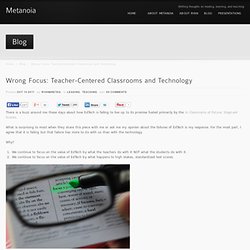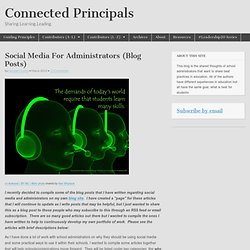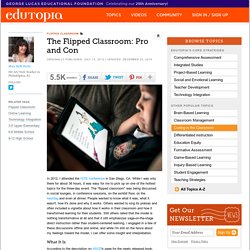

JISC Digital Literacies programme: A history of Digital Literacy in UK & EU #JISCDigLit — Digital Fingerprint. Hypocrisy in the Profession of Education. June 12, 2012 by tomwhitby Whenever I think of a teacher, I also think of a scholar.

It has always been apparent to me that if one is to be an effective teacher, one must continually learn. Of course that is not always a path that individuals are able follow as a straight line. Often things, or situations get in the way over the course of a lifetime and many stray from that path for the sake of time, money, or most often family. I attended a retirement party recently for some retiring colleagues, and I engaged in several conversations with a number of teachers who were attending the party about various education topics. I brought up topics like authentic learning; project based learning, the flipped classroom, and connected educators.
I clearly understand that teachers are under attack, both locally and nationally. 2011-Horizon-Report-K12.pdf. 21st Century Learning…blah blah blah. 40 Future Uses for Educational Technology [Infographic] Educators spend entire careers writing lesson plans and curricula to better prepare students for challenges they’ve yet to encounter.
![40 Future Uses for Educational Technology [Infographic]](http://cdn.pearltrees.com/s/pic/th/educational-infographic-35338454)
With the rapid advancement of technology, the nature of these challenges changes almost daily. The U.S. Department of Labor reports that 65 percent of grade-school students will end up in jobs that haven’t been invented yet. So, what exactly will the jobs of the future look like? Teachers Are Poor Consumers of Learning. July 24, 2012 by tomwhitby There are only a few explanations that many educators offer up as reasons not to learn and use any technology as tools for learning.

One of the most popular excuses, frequently cited by educators, is that there is not enough time to learn all of the stuff that is out there. It certainly is true that there are a huge number of things to learn out there that are linked to technology. Google launches YouTube curriculum to educate students on digital citizenship (video) Google has developed an interactive curriculum on YouTube to support teachers in educating students on how to be safe, engaged and confident model netizens.
The initiative is aimed at students aged 13 to 17 and will help them to develop digital literacy skills on YouTube that would be applicable across the web. A list of 10 lessons has been devised, in which students can learn about YouTube’s policies, how to report content, how to protect their own privacy, and how to be responsible YouTube community members and, in the broader picture, digital citizens. Each lesson comes with guidelines for teachers and ready-made slides for presentation.
There’s also a YouTube Curriculum channel where videos related to the project will be posted. Wrong Focus: Teacher-Centered Classrooms and Technology. There is a buzz around me these days about how EdTech is failing to live up to its promise fueled primarily by the In Classrooms of Future, Stagnant Scores.

What is surprising to most when they share this piece with me or ask me my opinion about the failures of EdTech is my response. For the most part, I agree that it is failing but that failure has more to do with us than with the technology. Why? Transliteracy- QR Codes and Art Transliteracy is defined on Wikipedia as The ability to read, write and interact across a range of platforms, tools and media from signing and orality through handwriting, print, TV, radio and film, to digital social networks.

The modern meaning of the term combines literacy with the prefix trans-, which means “across; through”, so a transliterate person is one who is literate across multiple media. Ryan Nadel, in an interview on Spotlight on Digital Media and Learning, defines transliteracy even further: “The most fundamental notion of transliteracy is the ability to adapt. Five-Minute Film Festival: Flipped Classrooms. I really enjoyed Mary Beth Hertz's excellent blog published earlier this week, "The Flipped Classroom: Pro and Con" -- one of the most concise and balanced views I've read on the buzz-wordy concept of flipping the classroom.

Advocates say that "flipped classrooms" help overburdened teachers differentiate their instruction to reach more learners, provide an avenue into more hands-on and student-driven learning during classtime, and shift the teacher's role from "sage on the stage" to learning coach and facilitator. Critics say it's just a fad, relies too heavily on rote instruction, and doesn't go far enough in making the needed changes for teaching and learning reform.
I've rounded up this list of videos so you can learn more about the challenges and benefits of flipped classrooms. Video Playlist: Flipping the Classroom Keep watching the player below to see the entire playlist, or view this playlist on YouTube. Social Media For Administrators (Blog Posts) Cc licensed ( BY NC ) flickr photo shared by Ken Whytock I recently decided to compile some of the blog posts that I have written regarding social media and administrators on my own blog site.

I have created a “page” for these articles that I will continue to update as I write posts that may be helpful, but I just wanted to share this as a blog post to those people who may subscribe to this through an RSS feed or email subscription. There are so many good articles out there but I wanted to compile the ones I have written to help to continuously develop my own portfolio of work. Please see the articles with brief descriptions below: Slides. The Flipped Classroom: Pro and Con. In 2012, I attended the ISTE conference in San Diego, CA.

While I was only there for about 36 hours, it was easy for me to pick up on one of the hottest topics for the three-day event. The "flipped classroom" was being discussed in social lounges, in conference sessions, on the exhibit floor, on the hashtag and even at dinner. People wanted to know what it was, what it wasn't, how it's done and why it works. Innovate My School - Innovation and inspiration for teachers. Help wanted: Sites that connect classrooms across the globe? The Real Reason Change Isn't Happening #iste12. Teachers know where they're going -- they're just afraid of what will happen when they get there "The biggest barrier to tech integration is professional development.

Simply giving teachers iPads won't change anything," I overhear someone saying in the Blogger's Cafe. What I Wish I’d Done Before Deploying iPads to 735 Middle Schoolers, Part 2. EdApps.ca. APPitic - 1,800+ EDUapps. Friday Institute for Educational Innovation - White Paper Series. Hiller Spires and Melissa Bartlett June 2012 Since technological advances are driving much of the change that we see in information and communication, researchers and educators are attempting to answer two important questions: What does it mean to be literate in the 21st century?

How do we design instruction that enables educators to cultivate digital literacies for themselves as well as their students? This white paper addresses the redefinition of literacy skills that enable students to be successful in today’s digital world and the implications this redefinition holds for their teachers. What's Your Social Media Summer Project? School of the Future. How Does Digital Literacy differ from Traditional Literacy and Which Comes First? « Effective Social & Digital Media Storytelling Blog. Digital Literacy - ICT Planning. ICT in the Early Years.
It's the Pedagogy, Stupid: Lessons from an iPad Lending Program. Recently, we were tasked with developing policies and procedures for an equipment lending program initiated within the Faculty Technology Resources Center at the University of Cincinnati. The program was conceived as a method for encouraging the use of technology in the classroom. Etherpad Foundation › Live Document Collaboration. IP glossary. This glossary helps explain some of the most important IP words, terms and concepts.
The Digital and Electronics Revolution Timeline memories from The People History Site. Learning to Learn in a Digital Age. The following is an excerpt from Communique - Higher Education Partnerships Newsletter . Learning to Learn in a Digital Age Howard Major, Ed. Moore’s Law Inspires Intel Innovation. Digital Education Revolution. Incorporating Innovation into Strategic Planning that Will Enrich Learning. It takes more than ensuring educators and students have access to technology when schools begin the work of developing a 21st century strategic school plan. As innovative educators, students, leaders, and families, are well aware, technology is just a tool. How to Teach Internet Safety in K-6. The Internet is a wonderful resource for kids for researching school reports, communicating with teachers, staying in touch with friends, and entertaining themselves.
21st Century Fluency Project. Digital literacy campaign. The 33 Digital Skills Every 21st Century Teacher should Have. By EdTech Team Updated on march 2, 2015 : The original list that was created in 2011 comprised 33 skills , after reviewing it we decided to do some merging and finally ended up with the 20 skills below. The 21st century teacher should be able to : Design Your Digital Classroom. Doug Belshaw (dajbelshaw. Digital Literacy Dover. Digital Learning Now. Cat's Pyjamas. Home Page. Digital literacy across the curriculum. The Magic of Learning. How To Integrate Multimedia For Effective Learning. Classroom 2.0. ACTF - Home. Digital Literacy Learning Activities for the Early Phase. : : m e t r o m a g a z i n e : : SCIL – Lead the change.
eLearning Articles.